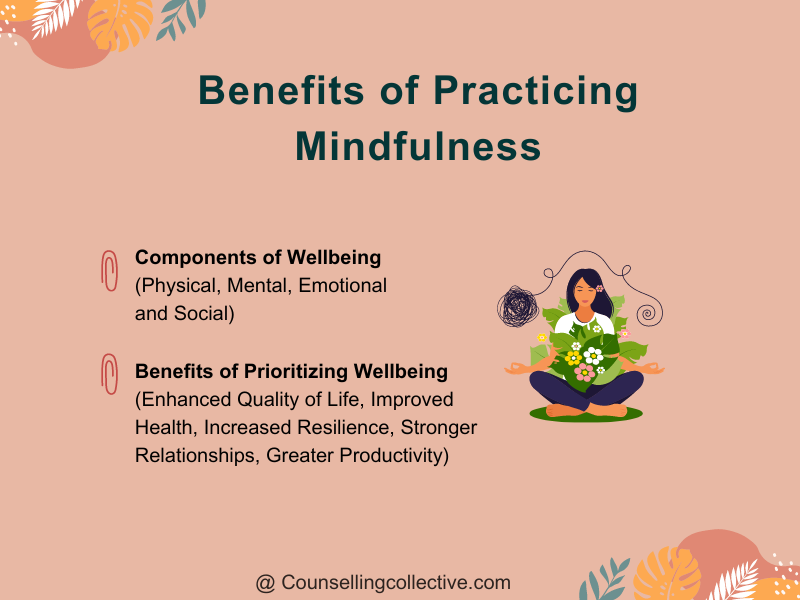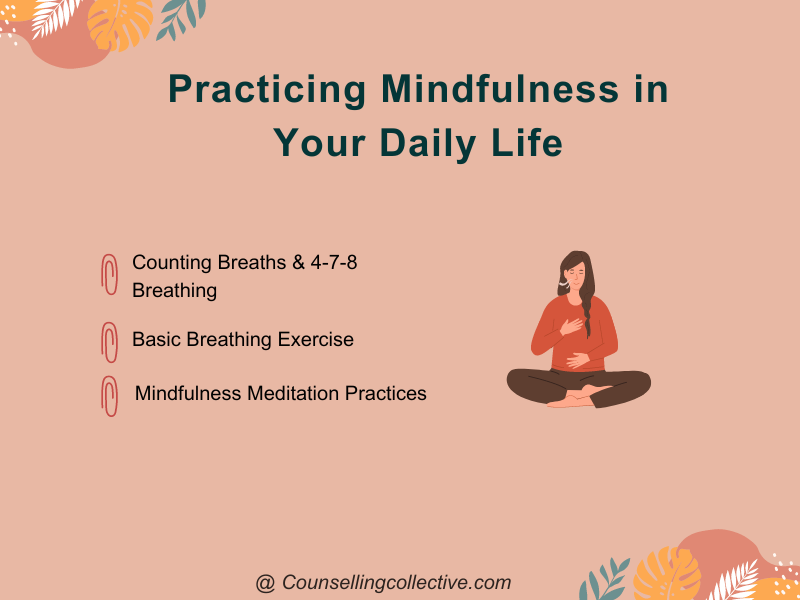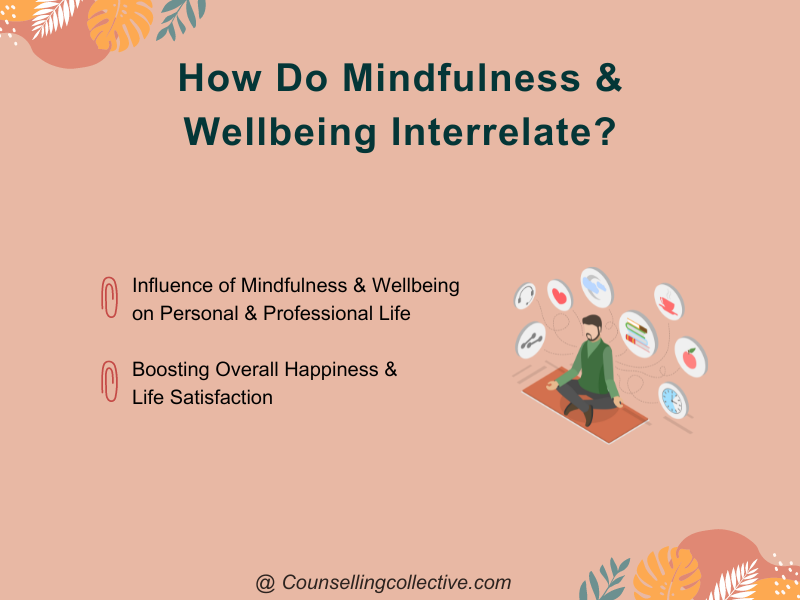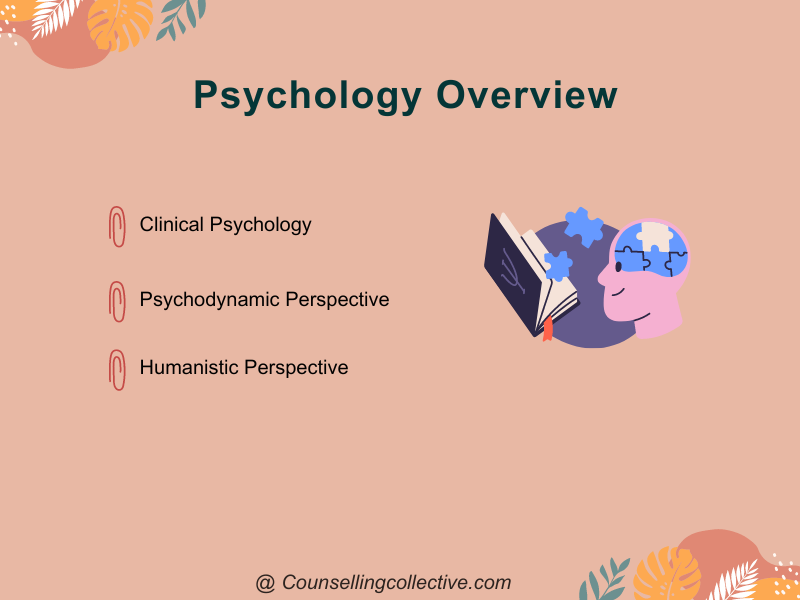Contents
- 1 Introduction
- 2 Benefits of Practicing Mindfulness
- 3 Practicing Mindfulness in Your Daily Life
- 4 Effective Strategies for Enhancing Wellbeing
- 5 How Do Mindfulness and Wellbeing Interrelate?
- 6 Encouraging Resilience and Coping Strategies
- 7 Psychology Overview: Key Concepts and Approaches
- 8 Common Challenges in Practicing Mindfulness & Wellbeing
- 9 FAQs on Mindfulness & Wellbeing
Introduction
Mindfulness is the practice of being fully present and engaged in the current moment, aware of your thoughts, feelings, and surroundings without judgment.
It involves paying attention to your experiences as they unfold, rather than getting lost in the past or future. This mental state can be cultivated through various techniques, including meditation, breathing exercises, and mindful movement.
In this article, we explore the practice of mindfulness and its significant impact on overall well-being. We explore the science behind mindfulness, its psychological and physiological benefits, and practical ways to incorporate it into daily life.

We also examine how mindfulness contributes to physical, mental, emotional, and social health, enhancing personal and professional success, and fostering resilience.
The Science Behind Mindfulness: Psychological and Physiological Benefits
Research has shown that mindfulness has a wide range of psychological and physiological benefits. Mindfulness can reduce stress, anxiety, and depression by promoting a state of calm and relaxation. Physiologically, mindfulness can lower blood pressure, improve immune function, and enhance sleep quality.
Neuroimaging studies have shown that regular mindfulness practice can change the brain’s structure, enhancing areas related to attention, emotion regulation, and self-awareness.
Importance of Mindfulness in Daily Life
Incorporating mindfulness into daily life is essential for managing the demands of modern living. By practicing mindfulness, individuals can improve their focus and productivity, enhance their relationships, and develop greater emotional resilience. Mindfulness helps people to respond to situations thoughtfully rather than reacting impulsively, leading to more balanced and thoughtful decision-making.
Benefits of Practicing Mindfulness
Practicing mindfulness offers a range of benefits that can significantly enhance overall well-being. By focusing on the present moment and cultivating a non-judgmental awareness, mindfulness can reduce stress, improve emotional regulation, and boost cognitive function.
These benefits can lead to a more balanced and fulfilling life, helping individuals navigate daily challenges with greater ease and clarity.

The benefits of mindfulness are extensive and well-documented:
| Reduced Stress | Mindfulness helps manage stress by encouraging a calm and focused mind. |
| Enhanced Emotional Regulation | Mindfulness improves the ability to manage emotions and reduces reactivity. |
| Improved Focus and Concentration | Practicing mindfulness enhances attention and cognitive functioning. |
| Better Physical Health | Mindfulness has been linked to reduced blood pressure, improved immune response, and better sleep. |
| Overall, mindfulness contributes to a sense of well-being and life satisfaction. | Overall, mindfulness contributes to a sense of wellbeing and life satisfaction. |
What is Well-being and Why Does it Matter?
Wellbeing is a holistic concept encompassing physical, mental, emotional, and social health. It refers to the state of being comfortable, healthy, and happy. Wellbeing is influenced by various factors, including lifestyle choices, relationships, work environment, and mental health.
Components of Wellbeing: Physical, Mental, Emotional and Social
Wellbeing is multidimensional and includes:
- Physical Wellbeing: Involves maintaining a healthy body through regular exercise, proper nutrition, and adequate sleep.
- Mental Wellbeing: Involves having a positive outlook on life, being able to cope with stress, and engaging in activities that stimulate the mind.
- Emotional Wellbeing: Involves understanding and managing emotions, having a sense of purpose, and maintaining a positive self-image.
- Social Wellbeing: Involves having supportive relationships, a sense of belonging, and being able to interact positively with others.
Mindfulness & Well Being
Mindfulness directly contributes to overall well-being by enhancing awareness and promoting a balanced lifestyle. Mindfulness practices help individuals manage stress, improve emotional regulation, and foster positive relationships. By being present and attentive, people can make healthier choices, appreciate their experiences more deeply, and maintain a positive outlook on life.
Benefits of Prioritizing Wellbeing
Prioritizing well-being has numerous benefits:
- Enhanced Quality of Life: A focus on well-being leads to greater life satisfaction and happiness.
- Improved Health: Better physical, mental, and emotional health results from prioritizing wellbeing.
- Increased Resilience: A strong sense of well-being enhances the ability to cope with stress and adversity.
- Stronger Relationships: Well-being fosters positive interactions and deeper connections with others.
- Greater Productivity: Wellbeing improves focus, motivation, and efficiency in both personal and professional life.
Practicing Mindfulness in Your Daily Life
Incorporating mindfulness into daily life can bring profound changes to how we experience each moment.
By making a conscious effort to be present and engaged in everyday activities, we can enhance our mental clarity, reduce stress, and improve emotional well-being.

Mindful breathing is a simple yet powerful way to practice mindfulness. It involves paying attention to the breath as it flows in and out of the body. Here are some techniques:
- Basic Breathing Exercise: Sit comfortably, close your eyes, and focus on your breath. Notice the sensation of the air entering and leaving your nostrils. If your mind wanders, gently bring your attention back to your breath.
- Counting Breaths: Inhale deeply and count “one” in your mind. Exhale and count “two.” Continue counting each breath up to ten, then start over. This helps maintain focus and prevents the mind from wandering.
- 4-7-8 Breathing: Inhale for a count of four, hold the breath for a count of seven and exhale for a count of eight. This technique is particularly effective for relaxation and stress reduction.
Mindfulness Meditation Practices
Mindfulness meditation involves sitting quietly and focusing on the present moment. Here are some practices:
- Body Scan Meditation: Lie down or sit comfortably. Close your eyes and bring your attention to different parts of your body, starting from your toes and moving up to your head. Notice any sensations without judgment.
- Loving-Kindness Meditation: Sit comfortably and silently repeat phrases like “May I be happy, may I be healthy, may I be safe.” Extend these wishes to others, including loved ones, acquaintances, and even those with whom you have difficulties.
- Guided Meditation: Use apps or recordings to guide you through a meditation session. This can be especially helpful for beginners.
Effective Strategies for Enhancing Wellbeing
Enhancing wellbeing involves adopting strategies that nurture both mental and physical health. By integrating practices such as regular exercise, balanced nutrition, and mindful relaxation techniques, individuals can create a solid foundation for overall wellness.

Healthy habits and routines are fundamental to well-being. Here are some strategies:
- Regular Exercise: Engage in physical activity that you enjoy, such as walking, running, yoga, or swimming. Aim for at least 150 minutes of moderate exercise per week.
- Balanced Diet: Eat a variety of nutritious foods, including fruits, vegetables, whole grains, and lean proteins. Avoid processed foods and excessive sugar.
- Adequate Sleep: Prioritize sleep by establishing a regular sleep schedule, creating a restful environment, and practicing good sleep hygiene.
Practicing Gratitude and Positive Thinking
Gratitude and positive thinking enhance well-being by shifting focus to the positive aspects of life. Here are some practices:
- Gratitude Journal: Write down three things you are grateful for each day. This can increase positivity and overall happiness.
- Positive Affirmations: Repeat positive statements about yourself and your life, such as “I am capable and strong” or “I am surrounded by love and support.”
- Reframing Negative Thoughts: When negative thoughts arise, challenge them and reframe them in a positive light. For example, instead of thinking, “I can’t do this,” think, “This is challenging, but I can learn and grow.”
Building Strong Social Connections
Strong social connections are vital for emotional and social well-being. Strategies include:
- Nurturing Relationships: Spend quality time with family and friends. Engage in meaningful conversations and activities.
- Joining Groups or Clubs: Participate in community groups, clubs, or organizations that align with your interests. This provides opportunities for social interaction and support.
- Volunteering: Helping others can increase feelings of connectedness and purpose. Volunteer for causes you care about.
How Do Mindfulness and Wellbeing Interrelate?
Mindfulness and well-being are deeply interconnected. Mindfulness practices enhance self-awareness, reduce stress, and promote positive behaviors, all of which contribute to overall well-being.

By fostering a present-moment awareness, mindfulness helps individuals make healthier choices, improve relationships, and enhance emotional resilience.
- Improved Mental Health: Individuals practicing mindfulness report reduced symptoms of depression and anxiety.
- Enhanced Physical Health: Mindfulness practices have been linked to lower blood pressure, improved immune function, and better sleep.
- Greater Life Satisfaction: People who practice mindfulness often experience increased life satisfaction and overall happiness.
Influence of Mindfulness & Wellbeing on Personal and Professional Life
Mindfulness can significantly improve personal relationships by:
- Promoting Better Communication: Mindfulness enhances listening skills and empathy, leading to more meaningful and effective communication.
- Reducing Conflict: Mindfulness helps individuals respond to conflicts calmly and thoughtfully, reducing reactivity and promoting resolution.
- Strengthening Connections: Mindfulness fosters deeper connections and trust in relationships by being present and attentive.
Boosting Overall Happiness and Life Satisfaction
Mindfulness contributes to overall happiness and life satisfaction by:
- Promoting a Positive Outlook: Mindfulness encourages a focus on positive experiences and reduces negative thinking.
- Enhancing Gratitude: Mindfulness fosters an appreciation for the present moment and the good things in life.
- Improving Emotional Wellbeing: Mindfulness reduces stress and anxiety, promoting a sense of calm and contentment.
Encouraging Resilience and Coping Strategies
Mindfulness enhances resilience and coping strategies by:
- Building Emotional Resilience: Mindfulness improves emotional regulation and the ability to manage stress and adversity.
- Promoting Healthy Coping Mechanisms: Mindfulness encourages positive coping strategies, such as mindful breathing and meditation, rather than negative behaviors like avoidance or substance use.
- Enhancing Adaptability: Mindfulness fosters a flexible and adaptive mindset, helping individuals navigate life’s challenges with greater ease.
Psychology Overview: Key Concepts and Approaches
Psychology offers a rich exploration of the human mind and behavior through various key concepts and approaches. Central to the field are theories of cognition, emotion, and motivation, which provide insights into how we think, feel, and act.
Major approaches, such as cognitive, behavioral, psychodynamic, and humanistic psychology, each offer unique perspectives and methodologies for understanding and addressing mental processes and issues..

This upcoming section explores key areas within psychology, including clinical psychology and major theoretical perspectives such as psychodynamic and humanistic approaches.
Clinical Psychology
Clinical psychology focuses on diagnosing and treating mental health disorders and emotional issues. Clinical psychologists use a range of techniques, including psychotherapy, cognitive-behavioral therapy (CBT), and psychodynamic therapy, to help individuals manage and overcome challenges. They often work in settings such as hospitals, private practices, and academic institutions, and may specialize in areas like anxiety disorders, depression, or trauma. Their goal is to improve individuals’ overall well-being and quality of life through evidence-based interventions.
Psychodynamic Perspective
The psychodynamic perspective, rooted in the work of Sigmund Freud, emphasizes the influence of unconscious processes and early life experiences on behavior and mental states. According to this approach, unresolved conflicts and repressed memories from childhood can manifest in various psychological issues in adulthood. Psychodynamic therapy aims to uncover these unconscious motivations and conflicts through techniques like free association and dream analysis. The perspective also explores how these unconscious factors impact interpersonal relationships and self-perception.
Humanistic Perspective
The humanistic perspective, championed by theorists such as Carl Rogers and Abraham Maslow, emphasizes individual potential and the importance of self-actualization. This approach focuses on the inherent goodness of people and their capacity for growth and self-improvement. Humanistic psychologists believe that individuals have an innate drive toward personal fulfillment and that psychological problems arise when this drive is thwarted. Techniques such as client-centered therapy, which promotes a supportive and non-judgmental therapeutic environment, are often used to help individuals explore their true selves and achieve personal goals.
Common Challenges in Practicing Mindfulness & Wellbeing
One of the main challenges in practicing mindfulness is overcoming distractions and maintaining focus. Strategies to address this include:
- Creating a Quiet Environment: Find a quiet space where you can practice mindfulness without interruptions.
- Setting a Regular Practice Schedule: Establish a regular time each day for mindfulness practice to build consistency.
- Using Guided Meditations: Guided meditations can help maintain focus and provide structure to your practice.
- Emotional Resistance: Confronting uncomfortable thoughts and emotions during mindfulness can be difficult and may lead to resistance.
- High Expectations: Setting unrealistic expectations for immediate calm and clarity can lead to frustration and disappointment.
- Cultural and Social Barriers: Lack of support or understanding from one’s social or cultural environment can be a hurdle.
- Perceived Lack of Time: Feeling that there isn’t enough time to dedicate to mindfulness practices due to other commitments.
- Mental Barriers: Pre-existing mental health conditions such as anxiety or depression can make mindfulness practices more challenging.
- Misconceptions about Mindfulness: Misunderstanding what mindfulness entails can lead to improper practice or abandonment of the practice altogether.
What Are Practical Tips for Sustaining a Mindfulness and Wellbeing Practice?
Use technology like mindfulness apps and digital journals to track progress, set reminders, and join online communities for support. Celebrate small victories to boost motivation, and integrate mindfulness into daily activities like eating, walking, and chores. Create a quiet environment for practice, start with manageable goals, and use guided meditations to maintain focus.
Practice self-compassion, stay anchored in the present moment, and seek support when needed. These strategies help sustain a consistent mindfulness and well-being practice, enhancing your overall quality of life.
Sustaining a mindfulness and well-being practice can be woven into everyday life with simple, practical tips. Start small by dedicating just a few minutes each day to mindfulness.
This could be a brief morning meditation, focusing on your breath, or practicing mindful eating by savoring each bite during a meal. Incorporate mindfulness into routine activities like walking, where you pay attention to each step and your surroundings. These small moments of awareness can accumulate and create a solid foundation for a sustained practice.
FAQs on Mindfulness & Wellbeing
Frequently asked questions about mindfulness and wellbeing often revolve around understanding their practices and benefits.
People commonly seek information on how mindfulness can be incorporated into daily routines, the science behind its effects on mental and physical health, and practical tips for maintaining consistency

How do I start practicing mindfulness?
To start practicing mindfulness, find a quiet place, sit comfortably, and focus on your breath. Use apps like Headspace or Calm for guided meditations. Begin with a few minutes daily and gradually increase the duration. Integrate mindfulness into everyday activities like eating and walking.
What if I find it difficult to focus during mindfulness practice?
If you find it difficult to focus during mindfulness practice, gently bring your attention back to your breath when your mind wanders. Start with short sessions and gradually increase the duration. Use guided meditations for structure and practice in a quiet, distraction-free environment.
Can mindfulness help with anxiety and stress?
Yes, mindfulness can help with anxiety and stress by promoting relaxation and a sense of calm. It helps individuals become more aware of their thoughts and feelings, reducing reactivity and improving emotional regulation. Regular practice can lead to lower stress levels and increased resilience.
How can I incorporate mindfulness into my busy schedule?
To incorporate mindfulness into a busy schedule, start with short sessions, like 5 minutes of mindful breathing. Integrate mindfulness into daily activities, such as eating, walking, or doing chores, by focusing fully on the present moment. Use mindfulness apps for guided meditations during breaks, and practice mindful listening during conversations to stay present.
Conclusion
Mindfulness and well-being are essential for leading a balanced, healthy, and fulfilling life. By practicing mindfulness, individuals can enhance their mental, emotional, and physical health, reducing stress, improving focus, and greater resilience.
Incorporating mindfulness into daily routines and prioritizing overall well-being fosters a positive outlook, stronger relationships, and increased life satisfaction. Start with simple practices, stay consistent, and utilize available resources to sustain these beneficial habits, ultimately enhancing your personal and professional success.
References
[1] Kabat-Zinn, J. (2013). Mindfulness for beginners: Reclaiming the present moment—and your life. Sounds True. Amazon
[2] Siegel, D. J. (2010). The mindful brain: Reflection and attunement in the cultivation of well-being. W.W. Norton & Company. Amazon
[3] Jon Kabat-Zinn, J. (2005). Wherever you go, there you are Mindfulness meditation in everyday life. Hyperion. Amazon
[4] Thich Nhat Hanh. (2015). The miracle of mindfulness: An introduction to the practice of meditation. Beacon Press. Amazon
[5] Goleman, D., & Davidson, R. J. (2017). Altered traits: Science reveals how meditation changes your mind, brain, and body. Avery. Amazon
[6] Harris, D. (2014). 10% happier: How I tamed the voice in my head, reduced stress without losing my edge, and found self-help that works—A true story. Dey Street Books. Amazon
[7] Neff, K. (2011). Self-compassion: The proven power of being kind to yourself. William Morrow Paperbacks. Amazon
[8] Brown, K. W., & Ryan, R. M. (2003). The benefits of being present: Mindfulness and its role in psychological well-being. Guilford Press. Amazon
[9] Davidson, R. J., & Begley, S. (2012). The emotional life of your brain: How its unique patterns affect the way you think, feel, and live—and how you can change them. Hudson Street Press. Amazon
[10] Nhat Hanh, T. (2014). Peace is every step: The path of mindfulness in everyday life. Bantam Books. Amazon
